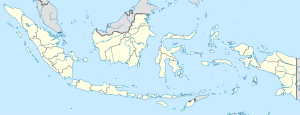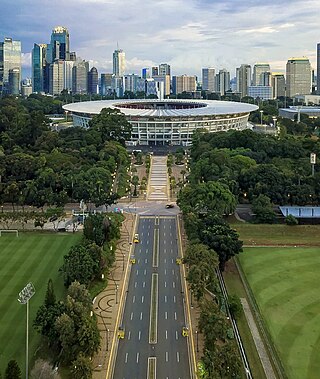
Gelora Bung Karno Main Stadium, formerly Senayan Main Stadium and Gelora Senayan Main Stadium, is a multi-purpose stadium located at the center of the Gelora Bung Karno Sports Complex in Central Jakarta, Indonesia. It is mostly used for football matches. The stadium is named after Sukarno, the then-president of Indonesia, who sparked the idea of building the sports complex.
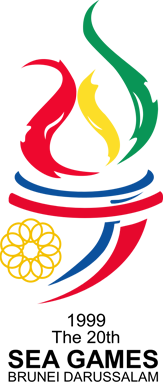
The 1999 SEA Games, officially known as the 20th SEA Games and commonly known as Brunei Darussalam 1999, was a Southeast Asian multi-sport event held in Bandar Seri Begawan, Brunei. This was the first time Brunei hosted the Southeast Asian Games and also in Borneo island. These were the last to have ever staged during the 20th century, and this was the only occasion, to date, that Brunei had held the SEA Games.

The 2001 Southeast Asian Games, officially known as the 21st Southeast Asian Games, was a Southeast Asian multi-sport event held in Kuala Lumpur, Malaysia. This was the fifth time that Malaysia plays as SEA Games hosts, the country previously held the event in 1965, 1971, 1977, and 1989, all of which were staged in Kuala Lumpur.

The 2003 Southeast Asian Games, officially known as the 22nd Southeast Asian Games, SEA Games 22 and also known as Vietnam 2003, was a Southeast Asian multi-sport event held from 5 to 13 December 2003 in Hanoi, Vietnam. This was the first time that Vietnam had staged the SEA Games, and it saw East Timor, which had just gained independence in 2002; although not being an ASEAN member and despite its geographical location closer to the Pacific archipelago than the Asian continent, making its debut at the games.
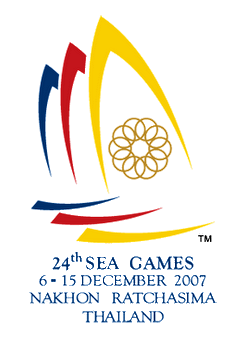
The 2007 Southeast Asian Games, officially known as the 24th Southeast Asian Games, was a Southeast Asian multi-sport event held in Nakhon Ratchasima (Korat), Thailand. This was the sixth time Thailand hosted the Southeast Asian Games and its first time since 1995. Previously, Thailand also hosted the 1959 inaugural games, 1967 games, 1975 games and the 1985 games.

The 2009 Southeast Asian Games, officially known as the 25th Southeast Asian Games, was a Southeast Asian multi-sport event hosted by Vientiane, Laos. This was the first time Laos had held the Southeast Asian Games as Laos had previously declined hosting the 1965 Southeast Asian Peninsular Games, citing financial difficulties. This was also the first time the Southeast Asian Games was held in a landlocked country.

The 2011 Southeast Asian Games, officially known as the 26th Southeast Asian Games, or the 26th SEA Games, and commonly known as Jakarta-Palembang 2011, was a Southeast Asian multi-sport event held from 11 to 22 November 2011 in Jakarta and Palembang, Indonesia. It was Indonesia's fourth time to host the Southeast Asian Games, and its first since 1997. Previously, Indonesia also hosted in 1979 and 1987. The capital city of Jakarta hosted all three of the previous Games prior to this. Palembang became the third SEA Games non-capital host city, after Chiang Mai (1995) and Nakhon Ratchasima (2007), both in Thailand. Around 5,965 athletes from 11 participating nations participated at the games which featured 545 events in 44 sports. The biggest competitor, sports, and events in Southeast Asian Games history.

Noshad Alamian Darounkolaei is an Iranian table tennis player.
The football tournament at the 1987 SEA Games was held from 10 to 20 September 1987 in Jakarta, Indonesia.
The football tournament at the 1997 SEA Games was held from 5 to 18 October in Jakarta, Indonesia. All 10 Southeast Asian nations competed in the tournament.
Gymnastics at the 2011 SEA Games was divided into three sub-categories: artistic gymnastics, rhythmic gymnastics, and aerobics. Artistic and Rhythmic Gymnastics were held at the Ranau Gymnastic Hall while Aerobics were held at the Dempo Hall, Palembang, Indonesia.
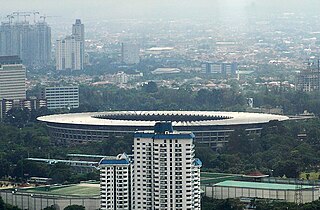
Bung Karno Sports Arena, formerly named Senayan Sports Arena from 1969 to 2001 and Asian Games Complex on its early days, is a sports complex located in Gelora, Central Jakarta, Indonesia. It is usually misperceived to be located at Senayan, South Jakarta, hence its former name. The sports complex hosts main stadium, secondary stadium, the Sports Palace, football fields, aquatic stadium, tennis stadiums, hockey, baseball and archery fields, and several indoor gymnasiums. The complex was built in 1960 for the 1962 Asian Games and recently underwent a major reconstruction for the 2018 Asian Games and Asian Para Games.
For main Top 5 Division, see: 2012 Asian Five Nations

The 2012 ASEAN University Games officially known as the 16th ASEAN University Games was a Southeast Asian university multi-sports event held in Vientiane, Laos. This was the first time Laos hosted the games. Laos is the eighth nation to host the ASEAN University Games after Thailand, Indonesia, Malaysia, Singapore, Brunei, Philippines and Vietnam.
The 2014 ASEAN University Games, officially known as the 17th ASEAN University Games, was a Southeast Asian university multi-sport event held in Palembang, Indonesia from 11 to 21 December 2014.

The 2013 Asian Youth Para Games, officially known as the 2nd Asian Youth Para Games, was an Asian youth disabled multi-sport event held in Kuala Lumpur, Malaysia from 26 to 30 October 2013. Around 1200 athletes from 29 participating nations participated at the games which featured 14 sports.

The 2016 ASEAN University Games, officially known as the 18th ASEAN University Games, was a Southeast Asian university multi-sports event held in Singapore. This was the third time Singapore hosted the ASEAN University Games, and its first time since 1994. Previously, Singapore also hosted the 1986 games.
Aquatics at the 1997 Southeast Asian Games included swimming, diving, synchronized swimming and water polo events and were held at Senayan Aquatic Centre in Jakarta, Indonesia. Aquatics events were held between 11 October to 16 October.

The 2008 ASEAN University Games, officially known as the 14th ASEAN University Games, was a Southeast Asian university multi-sport event held in Kuala Lumpur, Malaysia from 11 to 21 December 2008. This was the third time Malaysia hosted the games after 1984 and 1993.

Myanmar first competed at the ASEAN Para Games in 2001.

